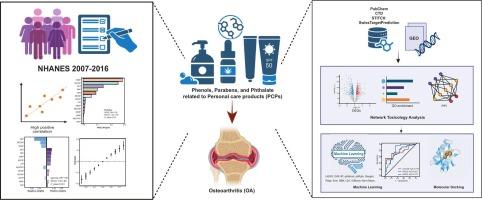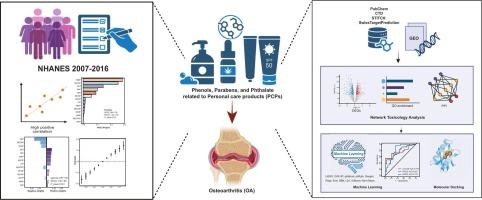个人护理产品与骨关节炎相关的酚类、对羟基苯甲酸酯和邻苯二甲酸酯化合物:基于人群和网络毒理学研究的证据
IF 9.7
1区 环境科学与生态学
Q1 ENVIRONMENTAL SCIENCES
引用次数: 0
摘要
骨关节炎(OA)是一种普遍存在的慢性肌肉骨骼疾病,在世界范围内导致严重的残疾,并因环境因素和个人护理产品(pcp)的暴露而加剧。本研究调查了苯酚、对羟基苯甲酸酯和邻苯二甲酸酯与pcp和OA之间的关系。使用广义线性模型评估了6972名国家健康与营养调查(NHANES)参与者尿液中14种pcps相关化学物质与OA患病率之间的关系。MCiOP、BP-3、BPA、MeP、PrP与OA呈显著正相关(P <; 0.05)。此外,通过限制三次样条(RCS)发现BP-3(非线性P = 0.0076)和BPA(非线性P = 0.0248)与OA存在非线性关联。此外,加权分位数和(WQS)、分位数g计算(qgcomp)和贝叶斯核机回归(BKMR)等混合暴露模型表明,pcps相关化学物质与OA之间存在总体正相关关系。网络毒理学分析鉴定出37个受pcp影响的潜在靶基因。其中,MFAP5、PRELP和cle3b被最优机器学习模型(LASSO + GBM)选择为关键目标。最后,通过分子对接技术验证了MFAP5和PRELP与pcps相关化学物质之间的相互作用。综上所述,本研究揭示了与pcp相关的酚类、对羟基苯甲酸酯和邻苯二甲酸酯与OA患病率显著相关,MFAP5和PRELP可能是pcp影响OA的潜在靶点。本文章由计算机程序翻译,如有差异,请以英文原文为准。


Associations of phenols, parabens, and phthalate compounds related to personal care products with osteoarthritis: evidence from population-based and network toxicology studies
Osteoarthritis (OA) is a prevalent chronic musculoskeletal disease leading to significant disability worldwide, exacerbated by environmental factors and exposure to personal care products (PCPs). This study investigated the associations between phenols, parabens, and phthalates related to PCPs and OA. The relationship between 14 PCPs-related chemicals in urine and the prevalence of OA in 6,972 participants from the National Health and Nutrition Examination Survey was assessed using generalized linear models. MCiOP, BP-3, BPA, MeP, and PrP were identified as having a significant positive correlation with OA. Furthermore, non-linear associations with OA for BP-3 and BPA was found by restricted cubic splines. Additionally, the mixed exposure models such as Weighted Quantile Sum, Quantile G-computation, and Bayesian Kernel Machine Regression indicated an overall positive association between PCPs-related chemicals and OA. Network toxicology analysis identified 37 potential target genes influenced by PCPs on OA. Among these, MFAP5, PRELP, and CLEC3B were selected as key targets by the optimal machine learning model (LASSO + GBM). Finally, molecular docking technology validated the interactions between MFAP5 and PRELP with PCPs-related chemicals. In summary, we herein reveal that phenols, parabens, and phthalates related to PCPs are significantly associated with the prevalence of OA, and MFAP5 and PRELP may be potential targets through which PCPs affect OA.
求助全文
通过发布文献求助,成功后即可免费获取论文全文。
去求助
来源期刊

Environment International
环境科学-环境科学
CiteScore
21.90
自引率
3.40%
发文量
734
审稿时长
2.8 months
期刊介绍:
Environmental Health publishes manuscripts focusing on critical aspects of environmental and occupational medicine, including studies in toxicology and epidemiology, to illuminate the human health implications of exposure to environmental hazards. The journal adopts an open-access model and practices open peer review.
It caters to scientists and practitioners across all environmental science domains, directly or indirectly impacting human health and well-being. With a commitment to enhancing the prevention of environmentally-related health risks, Environmental Health serves as a public health journal for the community and scientists engaged in matters of public health significance concerning the environment.
 求助内容:
求助内容: 应助结果提醒方式:
应助结果提醒方式:


